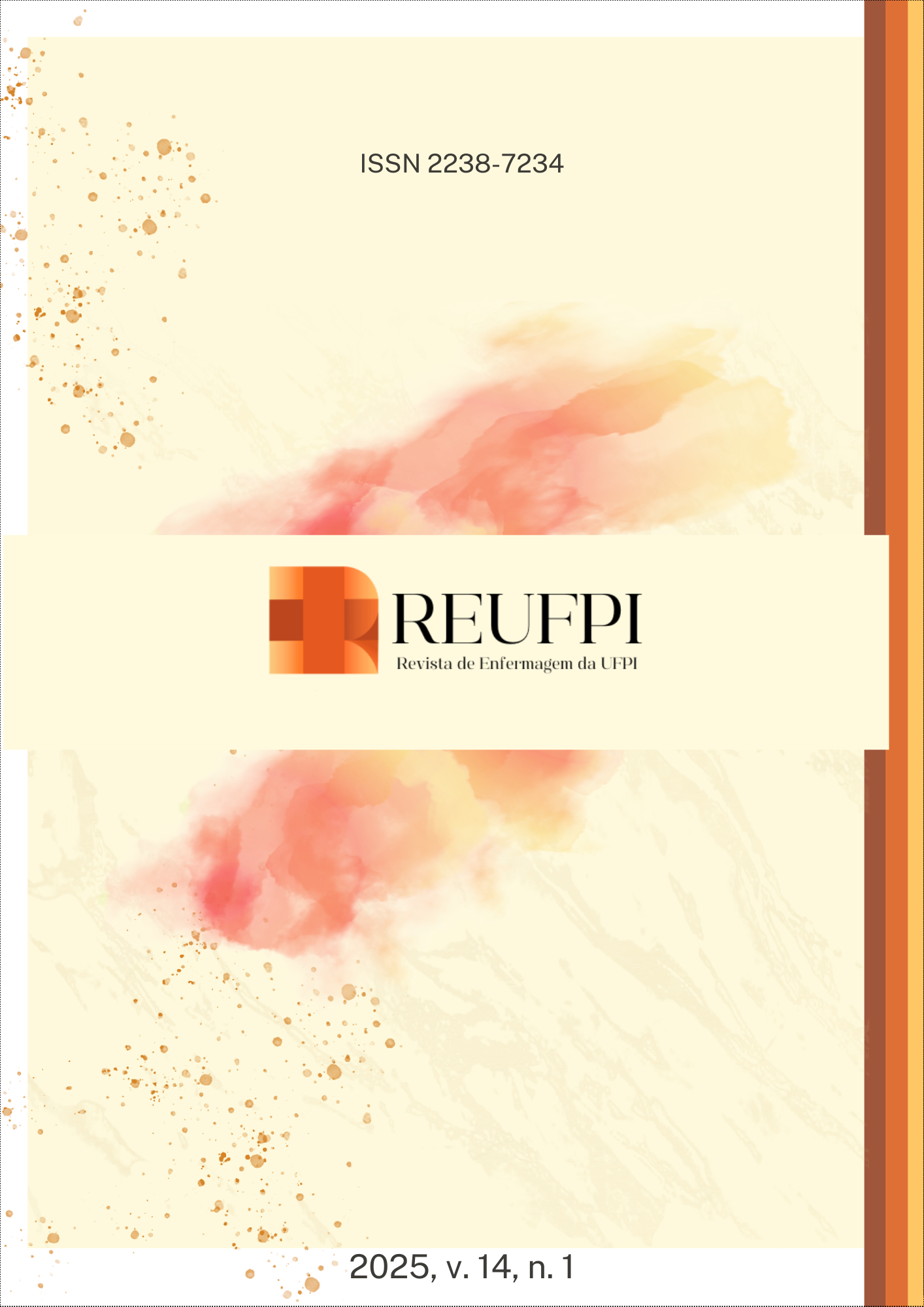Fatores de risco associados à violência contra a pessoa idosa institucionalizada: Revisão integrativa
DOI:
https://doi.org/10.26694/reufpi.v14i1.5551Palavras-chave:
Violência, Idoso, Abuso de Idosos, Fatores de Risco, Instituição de Longa Permanência para IdososResumo
Objetivo: Identificar na literatura os fatores associados à violência contra pessoas idosas residentes em Instituições de Longa Permanência para Idosos (ILPIs). Métodos: Revisão integrativa, realizada nas bases de dados: Medical Literature Analysis and Retrieval System online, SCOPUS, Web of Science, Índice Bibliográfico de Ciências da Saúde, Banco de Dados de Enfermagem e Literatura Latino Americana e do Caribe em Ciências da Saúde, entre outubro e novembro de 2023, sistematizada a partir do fluxograma PRISMA, com auxílio do software Rayyan, incluindo estudos primários sem restrição temporal ou de idioma, analisados e sintetizados pelo método descritivo. Resultados: A amostra final incluiu 20 estudos, em sua maioria publicados em inglês, desenvolvidos em países como Estados Unidos da América. Noruega e China e publicados entre os anos de 2004 e 2021, com predominância dos estudos exploratórios transversais. Foram identificados fatores de risco relacionados às características individuais das pessoas idosas residentes, da equipe que presta cuidados nesse cenário e da organização dos serviços e estrutura física das ILPIs. Conclusão: Por meio da revisão foi possível corroborar a multifatorialidade da violência contra a pessoa idosa residente em ILPIs, contribuindo para o desenvolvimento de ferramentas de prevenção de violência nesse contexto.
Referências
World Health Organization. National programmes for age-friendly cities and communities: a guide. Geneva: World Health Organization; 2023.
Amiri M. Problems Faced by Old Age People. The International Journal of Indian. 2018 [acesso em 2024 fev. 10];6(3):52–62. Doi: https://doi.org/10.25215/0603.026.
World Health Organization. Ageing and Health. 2018 February 5. Available from: https://www.who.int/news-room/fact-sheets/detail/ageing-and-health.
Sathya T, Premkumar R. Association of functional limitations and disability with elder abuse in India: a cross-sectional study. BMC geriatrics. 2020 [acesso em 2024 fev. 25]; 20:1–1. https://doi.org/10.1186/s12877-020-01619-3.
World Health Organization. Elder Abuse. 2017. Available from: http://apps.who.int/violence-info/elder-abuse/.
Storey JE. Risk factors for elder abuse and neglect: A review of the literature. Aggression and Violent Behavior. 2020 [acesso em 2024 fev. 19]; 50, 101339. Doi: https://doi.org/10.1016/j.avb.2019.101339.
Van Den Bruele AB, Dimachk M, Crandall M. Elder abuse. Clinics in Geriatric Medicine. 2019 [acesso em 2024 fev. 19]; 35(1), 103–13. Doi: https://doi.org/10.1016/j.cger.2018.08.009.
Jandu JS, Mohanaselvan A, Johnson MJ, et al. Elder Abuse. [Atualizado em 6 out. 2024]. In: StatPearls [Internet]. Treasure Island (FL): StatPearls Publishing; 2024 Jan-. Available from: https://www.ncbi.nlm.nih.gov/books/NBK560883/.
Yon, Y, Mikton, C, Gassoumis, ZD, Wilber, K. H. The prevalence of self-reported elder abuse among older women in community settings: A systematic review and meta-analysis. Trauma, Violence, & Abuse. 2017 [acesso em 2024 fev. 19]; 1524838017697308. https://doi.org/10.1177/1524838017697308.
Yon Y, Mikton CR, Gassoumis ZD, Wilber KH. Elder abuse prevalence in community settings:
A systematic review and meta-analysis. The Lancet Global Health. 2017 [acesso em 2024 fev. 19];
(2), e147–e156. Doi: https://doi.org/10.1016/S2214-109X(17)30006-2.
Santos MAB, et al. Fatores associados à violência contra o idoso: uma revisão sistemática da literatura. Ciência & Saúde Coletiva. 2020 [acesso em 2024 fev. 25]; 25(6): 2153-75. Doi: https://doi.org/10.1590/1413-81232020256.25112018.
Alcântara RKL, Cavalcante MLSN, Fernandes BKC, Lopes VM, Leite SFP, Borges CL. Perfil Sociodemográfico e de saúde de pessoa idosas institucionalizadas. Rev enferm UFPE on line. 2019 [acesso em 2024 fev. 10]; 13(3):674-9. Available from: https://periodicos.ufpe.br/revistas/revistaenfermagem/article/view/237384/31556.
Güths JFS, Jacob MHVM, dos Santos AMP, Arossi GA, Béria JU. Perfil de idosos institucionalizados no litoral norte gaúcho. Rev. Bras. Geriatr. Gerontol. Rio de Janeiro, 2017 [acesso em 2024 fev. 15]; 20(2): 175-85. Doi: https://doi.org/10.1590/1981-22562017020.160058.
Yon Y, Ramiro-Gonzalez M, Mikton CR, Huber M, Sethi D. The prevalence of elder abuse in institutional settings: A systematic review and meta-analysis. European Journal of Public Health. 2019 [acesso em 2024 fev. 19]; 29, 58–67. Doi: https://doi.org/10.1093/eurpub/cky093.
Whittemore R, Knafl K. The integrative review: updated methodology. J Adv Nurs. 2005 [acesso em 2024 fev. 19]; 52(5):546-53. Doi: https://doi.org/10.1111/j.1365-2648.2005.03621.x.
Lockwood C, Porrit K, Munn Z, Rittenmeyer L, Salmond S, Bjerrum M, et al. Chapter 2: Systematic reviews of qualitative evidence. In: Aromataris E, Munn Z, editors. Joanna Briggs Institute, 2017 [acesso em 2024 fev. 15]. Available from: https://wiki.jbi.global/display/MANUAL/Chapter+2%3A+Systematic+reviews+of+qualitative+evidence.
Mourad O, Hossam H, Zbys F, Ahmed E. Rayyan — a web and mobile app for systematic reviews. Systematic Reviews. 2016 [acesso em 2024 mar. 01]; 5:210. Doi: https://doi.org/10.1186/s13643-016-0384-4.
Moher D, Liberati A, Tetzlaff J, Altman DG. Preferred reporting items for systematic reviews and metaanalyses: the PRISMA statement. Plos Med. 2009 [acesso em 2024 fev. 23]; 6(6): e1000097. Doi: https://doi.org/10.1371/journal.pmed.1000097.
Marziale MH. Instrumento para recolección de datos revisión integrativa. Coordinadora REDENSO International, 2015. Ribeirão Preto (SP) USP; 2015 [acesso em 2024 fev. 20]. Available from: http://gruposdepesquisa.eerp.usp.br/sites/redenso/wp-content/uploads/sites/9/2019/09/Instrumiento_revision_litetarura_RedENSO_2015.pdf.
Phillips B, Ball C, Sackett D, Badenoch D, Straus S, Haynes B, et al. Levels of Evidence and Grades of Recommendation. Centre for Evidence-Based Medicine (CEBM). United Kingdom: 2021 [acesso em 2024 fev. 15]. Available from: http://www.cebm.net/.
Usta J, El Jarrah R, Kronfol N, Farver JM. Perspectives of elder abuse in Lebanon, Journal of Elder Abuse & Neglect. 2021 [acesso em 2024 fev. 19]; 33:1, 65-81. Doi: https://doi.org/10.1080/08946566.2021.1881013.
Botngård, A, Eide, AH, Mosqueda, L. et al. Factors associated with staff-to-resident abuse in Norwegian nursing homes: a cross-sectional exploratory study. BMC Health Serv Res. 2021 [acesso em 2024 fev. 11]; 21, 244. Doi: https://doi.org/10.1186/s12913-021-06227-4.
Chen W, Fang F, Chen Y, Wang J, Gao Y, Xiao J. The relationship between personality traits, caring characteristics and abuse tendency among professional caregivers of older people with dementia in long-term care facilities. J Clin Nurs. 2020 Sep [acesso em 2024 fev. 12]; 29(17-18):3425-34. Doi: https://doi.org/10.1111/jocn.15380.
Erol S, Gür K, Hellaç F, Canbay T. The Frequency of and Contributing Factors to the Psychological Abuse of Older People in Nursing Homes in Turkey. Clinical and Experimental Health Sciences. 2020 [acesso em 2024 fev. 12]; 10(4):428-34. Doi: https://doi.org/10.33808/marusbed.553271.
Alraddadi, K. Prevalence and Risk Factors of Elder Mistreatment in Sheltered Homes. Journal of Interpersonal Violence. 2022 [acesso em 2024 fev. 10], 37(3-4), 1588-1603. Doi: https://doi.org/10.1177/0886260520922354.
Wang F, Meng LR, Zhang Q, Li L, Nogueira BOCL, Ng CH, Ungvari GS, Hou CL, Liu L, Zhao W, Jia FJ, Xiang YT. Elder abuse and its impact on quality of life in nursing homes in China. Arch Gerontol Geriatr. 2018 Sep-Oct [acesso em 2024 fev. 19]; 78:155-9. Doi: https://doi.org/10.1016/j.archger.2018.06.011.
Andela, M, Truchot, D, Huguenotte, V. Work Environment and Elderly Abuse in Nursing Homes: The Mediating Role of Burnout. Journal of Interpersonal Violence. 2018 [acesso em 2024 fev. 10]; 088626051880360. Doi: https://doi.org/10.1177/0886260518803606.
Andela, M, Truchot, D, & Huguenotte, V. Job demands, emotional dissonance and elderly abuse: The moderating role of organizational resources. Journal of Elder Abuse & Neglect. 2018 [acesso em 2024 fev. 11], 1–17. https://doi.org/10.1080/08946566.2018.1514343.
Neuberg M, Železnik D, Meštrović T, Ribić R, Kozina G. Is the burnout syndrome associated with elder mistreatment in nursing homes: results of a cross-sectional study among nurses. Arh Hig Rada Toksikol. 2017 Sep 26 [acesso em 2024 fev. 28];68(3):190-7. Doi: https://doi.org/10.1515/aiht-2017-68-2982.
Gimm G, Chowdhury S, Castle N. Resident Aggression and Abuse in Assisted Living. J Appl Gerontol. 2016 Aug [acesso em 2024 fev. 15]; 37(8):947-64. Doi: https://doi.org/10.1177/0733464816661947.
Blumenfeld Arens, O, Fierz, K, Zúñiga, F. Elder Abuse in Nursing Homes: Do Special Care Units Make a Difference? A Secondary Data Analysis of the Swiss Nursing Homes Human Resources Project. Gerontology. 2016 [acesso em 2024 fev. 11]; 63(2), 169–79. Doi: https://doi.org/10.1159/000450787.
Malmedal W, Hammervold R, Saveman BI. The dark side of Norwegian nursing homes: factors influencing inadequate care. The Journal of Adult Protection. 2014 [acesso em 2024 fev. 20];16(3):133-51. Doi: https://doi.org/10.1108/JAP-02-2013-0004.
Simmons SF, Durkin DW, Rahman AN, Choi L, Beuscher L, Schnelle JF. Resident characteristics related to the lack of morning care provision in long-term care. Gerontologist. 2013 Feb [acesso em 2024 fev. 25]; 53(1):151-61. Doi: https://doi.org/10.1093/geront/gns065.
Conner T, Prokhorov A, Page C, Fang Y, Xiao Y, Post LA. Impairment and abuse of elderly by staff in long-term care in Michigan: evidence from structural equation modeling. J Interpers Violence. 2011 Jan [acesso em 2024 fev. 12]; 26(1):21-33. Doi: https://doi.org/10.1177/0886260510362880.
Bužgová R, Ivanová K. Violation of ethical principles in institutional care for older people. Nurs Ethics. 2011 Jan [acesso em 2024 fev. 11];18(1):64-78. Doi: https://doi.org/10.1177/0969733010385529.
Schiamberg LB, Barboza GG, Oehmke J, Zhang Z, Griffore RJ, Weatherill RP, von Heydrich L, Post LA (2011) Elder Abuse in Nursing Homes: An Ecological Perspective, Journal of Elder Abuse & Neglect. 2011, 23:2, 190-211. Doi: https://doi.org/10.1080/08946566.2011.558798.
Post, L, Page, C, Conner, T, Prokhorov, A, Yu Fang, BBJ. Elder Abuse in Long-Term Care: Types, Patterns, and Risk Factors. Research on Aging. 2010 [acesso em 2024 fev. 28]; 32(3), 323-48. Doi: https://doi.org/10.1177/0164027509357705.
Natan M.B., Lowenstein A, Eisikovits Z. Psycho-social Factors Affecting Elders’ Maltreatment in Long-term Care Facilities. International Nursing Review. 2010 [acesso em 2024 fev. 23]; 57, 113–20. Doi: https://doi.org/10.1111/j.1466-7657.2009.00771.x.
Wang JJ, Lin MF, Tseng HF, Chang WY. Caregiver factors contributing to psychological elder abuse behavior in long-term care facilities: a structural equation model approach. Int Psychogeriatr. 2009 Apr [acesso em 2024 fev. 19]; 21(2):314-20. Doi: https://doi.org/10.1017/S1041610208008211.
SEGG. Sociedad Española de Geriatría y Gerontología. La percepción de los profesionales sobre negligencia, abuso y maltrato a las personas mayores. Rev Esp Geriatr Gerontol. 2004 [acesso em 2024 fev. 25]; 39(4):240-54. Doi: https://doi.org/10.1016/S0211-139X(04)74966-5.
Ho, CSH, Wong, SY, Chiu, MM, Ho, RCM. Global prevalence of elder abuse: A meta-analysis and meta-regression. East Asian Archives of Psychiatry. 2017 [acesso em 2024 fev. 15]; 27, 43–55. Available from: https://www.easap.asia/index.php/component/k2/item/771-1703-v27n2-p43.
Gagnon, S., Nadeau, A., Tanguay, K. et al. Prevalence and predictors of elder abuse among older adults attending emergency departments: a prospective cohort study. Can J Emerg Med. 2023; 25:953–8. Doi: https://doi.org/10.1007/s43678-023-00600-4.
Yan, E, Chan, KL, Tiwari, A. A systematic review of prevalence and risk factors for elder abuse in Asia. Trauma, Violence, and Abuse. 2015 [acesso em 2024 fev. 19]; 16, 199–219. Doi: https://doi.org/10.1177/1524838014555033.
Dong, XQ. Elder abuse: Systematic review and implications for practice. Journal of the American Geriatrics Society. 2015 [acesso em 2024 fev. 12]; 63(6), 1214-38. Doi: https://doi.org/10.1111/jgs.13454.
Marshall, KA, Hale, DMSN. Elder Abuse. Home Healthcare Now. 2018 [acesso em 2024 fev. 20]; 36(1):51-2. Doi: https://doi.org/10.1097/NHH.0000000000000648.
Braaten KL, Malmedal W. Prevenir o abuso físico de residentes de lares de idosos - visto da perspectiva da equipe de enfermagem. Enfermeira Aberta. 2017 [acesso em 2024 fev. 11]; 4 (4):274–81. Doi: https://doi.org/10.1002/nop2.98.
Mileski M, Lee K, Bourquard C, Cavazos B, Dusek K, Kimbrough K, Sweeney L, McClay R. Preventing The Abuse Of Residents With Dementia Or Alzheimer's Disease In The Long-Term Care Setting: A Systematic Review. Clin Interv Aging. 2019 Oct 22 [acesso em 2024 fev. 20]; 14:1797-815. Doi: https://doi.org/10.2147/CIA.S216678.
Alves MB, Menezes MR, Felzemburg RDM, Silva VA, Amaral JB. Long-stay institutions for the elderly: physical-structural and organizational aspects. Esc Anna Nery [Internet]. 2017 [acesso em 2024 fev. 10]; 21(4):e20160337. Doi: http://dx.doi.org/10.1590/2177-9465-ean-2016-0337.
Pereira JB, Pimenta CJL, Carmo AP, Filgueiras TF, Pereira MG, Castro AP. Marcas da violência entre pessoas idosas. R. pesq.: cuid. fundam. Online, 2020 jan/dez [acesso em 2024 fev. 28]; 12:928-33. Doi: http://dx.doi.org/0.9789/2175-5361.rpcfo.v12.7991.
López J, Pérez-Rojo G, Noriega C, Velasco C. Personal and Work-Related Factors Associated with Good Care for Institutionalized Older Adults. Int J Environ Res Public Health. 2021 Jan 19 [acesso em 2024 fev. 15];18(2):820. Doi: https://doi.org/10.3390/ijerph18020820.
World Health Organization. Long-term care for older people: package for universal health coverage. Geneva: World Health Organization; 2023.
Friedman L, Avila S, Friedman D, Meltzer W. Association between Type of Residence and Clinical Signs of Neglect in Older Adults. Gerontology 16 January 2019 [acesso em 2024 fev. 12]; 65(1):30–9. Doi: https://doi.org/10.1159/000492029.
Radermacher, H, Toh, YL, Western, D, Coles, J, Goeman, D, Lowthian, J. (2018). Staff conceptualisations of elder abuse in residential aged care: A rapid review. Australasian Journal on Ageing. 2018 [acesso em 2024 fev. 28]. Doi: https://doi.org/10.1111/ajag.12565.
Downloads
Publicado
Como Citar
Edição
Seção
Licença
Copyright (c) 2025 Rev Enferm UFPI

Este trabalho está licenciado sob uma licença Creative Commons Attribution 4.0 International License.
Autores mantém os direitos autorais e concedem à REUFPI o direito de primeira publicação, com o trabalho licenciado sob a Licença Creative Commons Attibution BY 4.0 que permite o compartilhamento do trabalho com reconhecimento da autoria e publicação inicial nesta revista.






